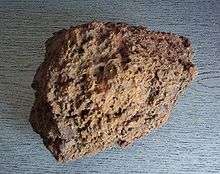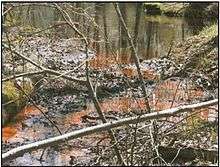Bog iron
Bog iron is a form of impure iron deposit that develops in bogs or swamps by the chemical or biochemical oxidation of iron carried in solution. In general, bog ores consist primarily of iron oxyhydroxides, commonly goethite (FeO(OH)).
Iron-bearing groundwater typically emerges as a spring. The iron is oxidized to ferric hydroxide upon encountering the oxidizing environment of the surface. Bog ore often combines goethite, magnetite and vugs or stained quartz. Oxidation may occur through enzyme catalysis by iron bacteria. It is not clear whether the magnetite precipitates upon first contact with oxygen, then oxidizes to ferric compounds, or whether the ferric compounds are reduced when exposed to anoxic conditions upon burial beneath the sediment surface and reoxidized upon exhumation at the surface.
Iron made from bog ore will often contain residual silicates, which can form a glassy coating that imparts some resistance to rusting.
Europe and the North
Iron smelting from bog iron was invented during the Pre-Roman Iron Age, and most Viking era iron was smelted from bog iron. The bog iron deposits of Northern and Northeastern Europe were created after the Ice Age ended, on postglacial plains. The dominant source of iron ore in Scandinavia and Russia into the Middle Ages was bog-ore. Even after improved smelting technology made mined ores viable during the Middle Ages, bog ore remained important, particularly to peasant iron production, into modern times.[1] In Russia, bog ore was the principal source of iron until the 16th century, when the superior ores of Ural Mountains became available.
"Streams carry dissolved iron from nearby mountains. In the bog, the iron is concentrated by two processes. The bog environment is acidic, with a low concentration of dissolved oxygen. In the acidic environment of the bog, a chemical reaction forms insoluble iron compounds which precipitate out. But more importantly, anaerobic bacteria (Gallionella and Leptothrix) growing under the surface of the bog concentrate the iron as part of their life processes...Their presence can be detected on the surface by the iridescent oily film they leave on the water ... another sure sign of bog iron. In Iceland, the film is called jarnbrák (iron slick). When a layer of peat in the bog is cut and pulled back using turf knives, pea sized nodules of bog iron can be found and harvested. Although the iron nodules are reasonably pure, there aren't many of them. They are, however, a renewable resource. About once each generation, the same bog can be re-harvested."[2]
North America
Pre-Columbian
Iron may have been produced by Vikings at L’Anse aux Meadows, Point Rosee and other locations in Newfoundland around 1000 AD.[3][4]
Colonial North America
Bog iron was widely sought in colonial North America. The earliest known iron mine in North America are the mines from St. John's, Newfoundland reported to be in operation by Anthony Parkhurst in 1578.[5] The first mining efforts in Virginia occurred as early as 1608. In 1619 Falling Creek Ironworks was established in Chesterfield County, Virginia. It was the location of the first blast furnace facility in North America.[6][7]
Lake Massapoag in Massachusetts was drawn down by deepening the outlet channel in a search for bog iron.[8] The Saugus Iron Works National Historic Site, on the Saugus River in Saugus, Massachusetts operated between 1646 and 1668. The site contains a museum and several reconstructed buildings.[9] The success of the Saugus Iron Works, and the rapid depletion of the region's natural bog iron, led them to send prospectors into the surrounding countryside. In 1658 they bought 1,600 acres (6.5 km2) of land which covered areas that are now Concord, Acton, and Sudbury. They set up a large production facility in Concord, Massachusetts, along the Assabet River with dams, ponds, watercourses and hearths, but by 1694 the natural bog iron there had also been exhausted, and the land was sold for farming.[10]
In Central and Southern New Jersey, bog ore was mined and refined for the production of naturally rust-resistant tools and wrought iron rails, many of which still grace staircases in Trenton and Camden. During the American Revolution, bog iron cannonballs were cast for the colonial forces.
Bog iron was also found on the Eastern Shore of Maryland. The remains of a commercial smelting operation near Snow Hill, Maryland are now a state and national historic site. Known as Furnace Town, it was called the Nassawango Iron Furnace after the nearby creek. The commercial furnace ran from about 1825 to 1850.
See also
- Limonite
- Iron ore
- Ore genesis
- Acidithiobacillus ferrooxidans (iron-oxidizing bacteria)
- History of ferrous metallurgy
References
- ↑ Maria Sjöberg and Anton Tomilov, “Iron-Making in Peasant Communities,” in Iron-making Societies: Early Industrial Development in Sweden and Russia, 1600–1900, ed. Maria Ågren, 33–60 (New York: Berghahn, 1998), 33–36, 59–60; Anders Florén, Göran Rydén, Ludmila Dashkevich, D. V. Gavrilov and Sergei Ustiantsev, “'The Social Organisation of Work at Mines, Furnaces and Forges,” in Iron-making Societies: Early Industrial Development in Sweden and Russia, 1600–1900, ed. Maria Ågren, 61–138 (New York: Berghahn, 1998), 62–65.
- ↑ "Iron Production in the Viking Age". Hurstwic. William R. Short. Retrieved 25 October 2016.
- ↑ Strauss, Mark (31 March 2016). "Discovery Could Rewrite History of Vikings in New World". National Geographic. National Geographic Partners, LLC. Retrieved 25 October 2016.
- ↑ Kaplan, Sarah (2 April 2016). "An ancient site spotted from space could rewrite the history of Vikings in North America". SentinelSource.com. SentinelSource.com, Keene, NH. Retrieved 25 October 2016.
- ↑ "LETTER FROM ANTHONY PARKHURST TO RICHARD HAKLUYT, Lawyer, 1578" (PDF).
- ↑ Hatch, Charles E., Jr.; Gregory, Thurlow Gates (July 1962). "The First American Blast Furnace, 1619-1622: The Birth of a Mighty Industry on Falling Creek in Virginia". The Virginia Magazine of History and Biography. Virginia Historical Society. 70 (3): 259–296. JSTOR 4246864.
- ↑ Geist, Christopher. "The Works at Falling Creek". Colonial Williamsburg. The Colonial Williamsburg Foundation. Retrieved 25 October 2016.
- ↑ Diana Muir, Reflections in Bullough's Pond, University Press of New England, 2000.
- ↑ "Saugus Iron Works". National Park Service. National Park Service, U.S. Department of the Interior. Retrieved 25 October 2016.
- ↑ "Archived copy". Archived from the original on 2010-10-22. Retrieved 2010-08-23. The Concord Iron Works
External links
| Wikimedia Commons has media related to Bog iron. |
- ASME PDF file with detailed reconstruction drawings of the furnace and surroundings.
- Nassawango Furnace at the Maryland Historic Trust.
-
 "Bog Ore". The American Cyclopædia. 1879.
"Bog Ore". The American Cyclopædia. 1879.


